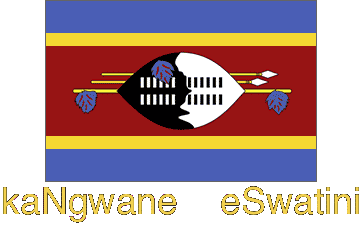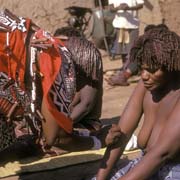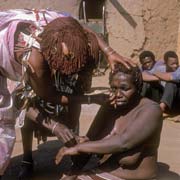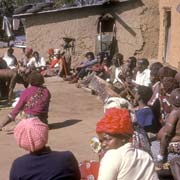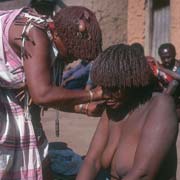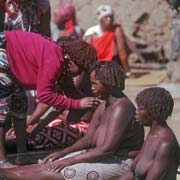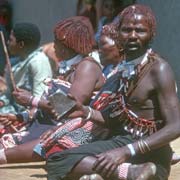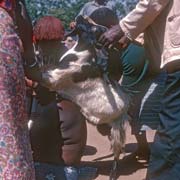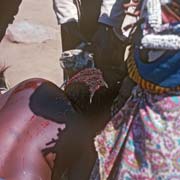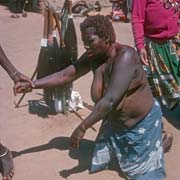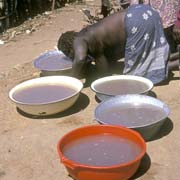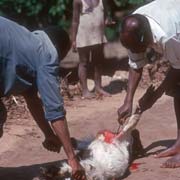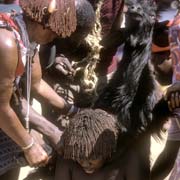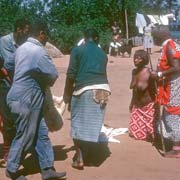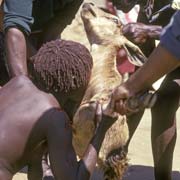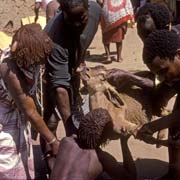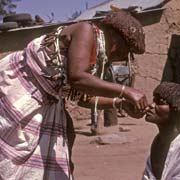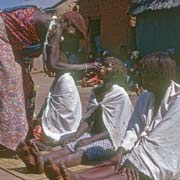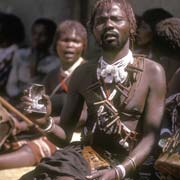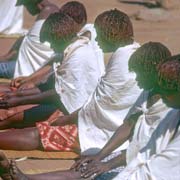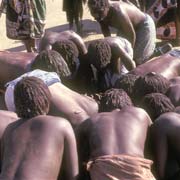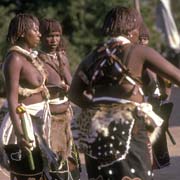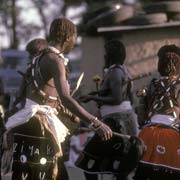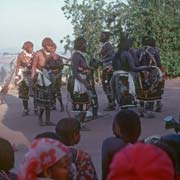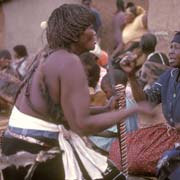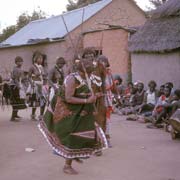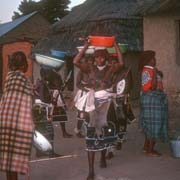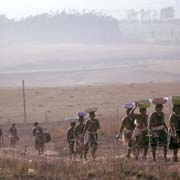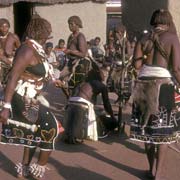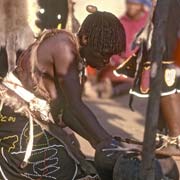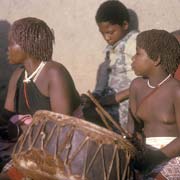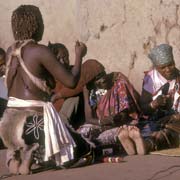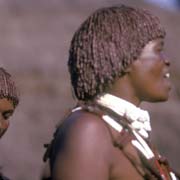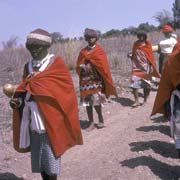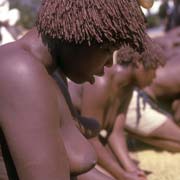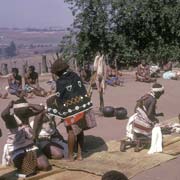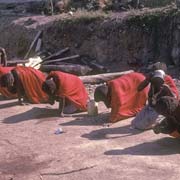Photos of An iNtfwasa graduation Ceremony in 1973, Swaziland
An iNtfwasa graduation Ceremony in 1973
LaMabuza's small homestead of Bethany, near Matsapha in central Swaziland was a "school" where about a dozen or more learner "tangoma" (plural of "sangoma"), diviners or "witchdoctors" were staying, working the fields and receiving their ritual instructions, having to observe various taboos. Each year a two day "kuphotfulwa" ceremony was held, finishing their "iNtfwasa" period, where the candidates had to undergo a series of tests and rituals that, when they passed, would make them fully qualified "tangoma".
you may then send it as a postcard if you wish.
The ceremonies started with the candidates being led outside, one by one, on their knees as a sign of submission to the "emadloti", ancestral spirits. They sat down on mats and LaMabuza made small incisions on their shoulders, wrists and elbows, rubbing "umutsi", traditional medicine, in the cuts. After that each candidate had a goat placed on her shoulders; a man swiftly pierced the goat's heart with a large knife and the candidate turned around, pressed her lips against the wound and drank the blood as it gushed out. She then walked on hands and knees to one of the large bowls, filled with medicine (water in which herbs had been steeped), drank deeply and then vomited the blood out, repeating this a few times. This was a test if they had observed the taboos: if not, the blood would clot in their stomachs and they would surely die.
The goats were butchered and small pieces of liver were placed on a shallow dish and one of the "bogobela" (senior tangoma) dragged it along the ground. The candidates, on hands and knees, ran after it, trying to eat it, fighting "like dogs" over it. LaMabuza explained that this would give them courage (liver, "sibindzi" in the siSwati language, is a symbol of courage), not to be afraid of even very sick people and being competitive with other tangoma to acquire customers. After this they had to drink "umutsi" medicine again and vomit it out to cleanse themselves before being led to the "indumba", the hut they were staying in.
The candidate tangoma then dressed themselves in full regalia, black skirts, embroidered with small beads, in the "indumba" and then emerged, in a light trance, on the plaza where large drums were pounded in a rhythm associated with the "emadloti" spirits. They danced in a circle, brandishing short dancing sticks, and then would jump up on one leg for a few beats. They would then be led, one by one, to their teacher LaMabuza and two other "bogobela", senior tangoma, to be examined in the skill of "kuphengula" or divining: the gall bladder of the goat that had been killed for them has been hidden and, by divination, she would find out where it was. After she had retrieved it, it was tied into her hair by one of the "bogobela" as a sign of her acquired seniority. The drumming and dancing continued for hours and every sangoma practiced divination in this way with the people who had been watching the proceedings; all suggestions by the sangoma were always answered with "siyavuma" (we agree) but, maybe from the from the tone this was said, they could divine if they were on the right track. Then, after a final dance, they retired for the night.
Early the following morning the new tangoma walked to the river with, on large dishes, the remains of the goats that had been killed for them the previous day. They had to go alone, nobody could follow them there. When they came back, a man appeared with a stick and chased them around the compound. "This is the last time someone pushes them around, from now on they will have authority as qualified diviners", LaMabuza explained later.
The people had assembled at one side of the plaza and the drums were pounding out again the rhythm of the "emadloti" or ancestral spirits. The new tangoma practiced their skills in "kuphengula" or divination; people might have hidden something, like a small coin and the sangoma would have to try to find it by divination, from the tone of the one reply ("siyavuma", we agree) that would be given to her suggestions. It might be hidden in a clay pot that was placed in the middle of the dancing ground.
The candidates were then draped in red cloth and the rhythm of the drums changed: this was the rhythm of the emaNdzawe (or Ndau, a people living in Mozambique and Zimbabwe): long ago, a group of Swazis, marauding in the area had come across some cattle belonging to those emaNdzawe; they had been told not to kill those as these cows were reserved to be offered to the ancestral spirits. The Swazi ignored this, killed the cattle and also killed those people daring to oppose them. Since that time the emaNdzawe spirits haunted them and need to be placated in these ceremonies. They were led out of the village towards the river where, one after the other, they were pushed under water three times, after having been treated with "umutsi". They "died" as ordinary human beings and were then transported back to the village.
Back in the village, to the unceasing pounding of the drums beating out the "emaNdzawe" rhythm, one of the "bogobela" or senior tangoma lightly brushed the "dead" tangoma under the nose with a "sizinga", a special brush, that brought them "back to life" again, reborn as fully qualified "tangoma" or diviners. The new diviners were then helped into an "umfembi", a device draped around their upper body. This would help them to "smell out" bad sprits that might have entered the bodies of their patients. They then performed a "kufemba" ritual on the people of the village, in which they also carried a "sizinga", a brush that contains, like the "umfembi", magical ingredients; the most important of that is the nose of a hyena: a hyena has a very keen sense of smell and this would help the sangoma to smell out that spirit body.
After this the new tangoma had to sit on a mat and one of the "bogobela" or senior tangoma performed this same kufemba ritual on them. Here too, bad spirits were smelled and sneezed out. Now the newly qualified tangoma were "clean" and then, the red cloths still draped around their shoulders, drank more "umutsi", water with traditional medicine in it, calmly stuck a finger in their throats and vomited it out again to be cleansed: they were now ready to start life as a fully qualified sangoma.
See also: iNtfwasa Ceremony - 1972 - Day 1 and Day 2,Video iNtfwasa Ceremony, 1973 - Day 1 and Day 2, and an explanation of the sangoma ceremonies.


